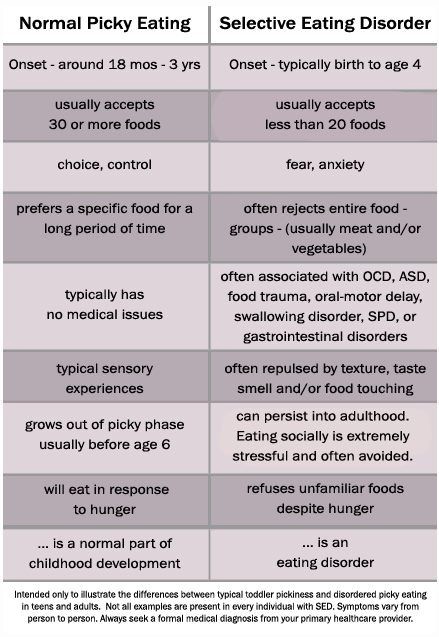Picky Eating or Selective Eating Disorder

Children and adults often share their concerns of having very restricted food choices with their healthcare professional. Dietary preferences may be limited to a handful of foods which are often refined carbohydrates. Could these restrictions be just picky eating or could it be something referred to as selective eating disorder?
What is Selective Eating Disorder?
Selective Eating Disorder is an eating disorder characterized by the refusal to eat specific foods due to its texture, color or smell. It could also be due to fear of experiencing a negative reaction from that particular food. The high restrictions of food can be very similar to picky eating and neither condition is related to concerns of body image.
Common similarities with both picky eating and Selective Eating Disorder (or AFRID):
- affects both children and adults
- limited choice of food items
- nutritional deficiencies
- behavioral challenges
- various health challenges
Differences between picky eating and Selective Eating Disorder*:

Selective Eating Disorder has now been clarified in the Diagnostic and Statistical Manual of Mental Disorders (DSM-5) as Avoidant/Restrictive Food Intake Disorder (ARFID). This condition was formerly referred to as “Feeding Disorder of Infancy or Early Childhood”. The DSM-5 has recognized that this eating disorder is not limited to children but now also includes adults.
Conditions that co-occur with AFRID can be sensory processing disorder, anorexia or bulimia, food associated with learned fear (negative previous experience), or lack of interest in food. Two other conditions associated with selective eating disorder are autism and anxiety. Children diagnosed with ASD tend toward picky eating and may need therapy to overcome their poor dietary habits. Anxiety is often a problem with eating disorders although it’s not about body image. This type of anxiety is for fear of choking, vomiting or having a bad experience with the food item.
What can be done to help those suffering from Picky Eating or Selective Eating Disorders?
Both picky eaters and selective eating disorders can be helped through cognitive behavioral therapy and with a program such as the Picky Eaters Palette.
In full disclosure, the Picky Eaters Palette program has been created by Better with Nutrition.
The Picky Eaters Palette program has been designed for individuals of all ages to overcome dietary challenges.
Picky Eaters Palette combines nutritional strategies with proven therapeutic concepts and uses step-by-step instructions on how to achieve success.
It is easy to follow for individuals and families, therapists, educators or any one in the professional field. Picky Eaters Palette can be used in an in-home or a group setting.
Read more about the Picky Eaters Palette here!
With time and patience, both picky eaters and those with selective eating disorder can become healthier individuals.
*Reference: Huntington Post
